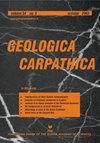Villány (Villány Hills,匈牙利)中晚三叠世剑龙和其他始祖类爬行动物遗骸
IF 1.5
4区 地球科学
Q4 GEOSCIENCES, MULTIDISCIPLINARY
引用次数: 2
摘要
在Villány (Villány Hills,匈牙利南部)的中上三叠统浅海沉积剖面中发现了剑龙和其他可能的原蜥脚类化石。根据椎骨明显拉长、椎体中空、神经脊柱极度缩小等特征,可将4块颈椎碎片归属于Tanystropheus sp.。除了颈部,各种各样的牙齿,被分为四种不同的形态,包括纵向条纹的,脊状的和锯齿状的,被认为属于原蜥目动物,因为它们明显不同于经常发现的鱼类和蜥目动物的牙齿。此外,还发现了三个神秘的头骨,可能代表了一些眶周元素,在这里被称为indedt。这些化石与罗马尼亚比霍尔(Bihor)的阿尼西亚(Anisian)的化石来自同一构造单元,对于更好地了解中欧中至晚三叠世的半水生到陆生脊椎动物动物群具有重要意义。本文章由计算机程序翻译,如有差异,请以英文原文为准。
Tanystropheus and other archosauromorph reptile remains from the Middle and Late Triassic of Villány (Villány Hills, Hungary)
Tanystropheus and other possible archosauromorph fossils have been discovered from Middle to Upper Triassic shallow marine sedimentary sections in Villány (Villány Hills, southern Hungary). Four fragmentary cervical vertebrae can be assigned to Tanystropheus sp. based on characteristic features including the strongly elongate and hollow vertebral body with extremely reduced neural spine. Besides the cervicals, various teeth, classified into four different morphotypes including longitudinally striated, carinated and ziphodont ones, are thought to belong to archosauromorphs, since they markedly differ from the frequently found teeth of fish and sauropterygians. In addition, three enigmatic cranial bones that might represent some circumorbital elements, have been found as well, and are referred to here as Sauropsida indet. These fossils, originated from the same tectonic unit as those from the Anisian of Bihor (Romania), are of great importance for a better understanding of the poorly known semi-aquatic to terrestrial vertebrate fauna of the Middle to Late Triassic of central Europe.
求助全文
通过发布文献求助,成功后即可免费获取论文全文。
去求助
来源期刊

Geologica Carpathica
地学-地球科学综合
CiteScore
2.40
自引率
23.10%
发文量
26
审稿时长
>12 weeks
期刊介绍:
GEOLOGICA CARPATHICA covers a wide spectrum of geological disciplines including geodynamics, tectonics and structural geology, volcanology, stratigraphy, geochronology and isotopic geology, karstology, geochemistry, mineralogy, petrology, lithology and sedimentology, paleogeography, paleoecology, paleobiology and paleontology, paleomagnetism, magnetostratigraphy and other branches of applied geophysics, economic and environmental geology, experimental and theoretical geoscientific studies. Geologica Carpathica , with its 60 year old tradition, presents high-quality research papers devoted to all aspects not only of the Alpine-Carpathian-Balkanian geoscience but also with adjacent regions originated from the Mediterranean Tethys and its continental foreland. Geologica Carpathica is an Official Journal of the Carpathian-Balkan Geological Association.
 求助内容:
求助内容: 应助结果提醒方式:
应助结果提醒方式:


